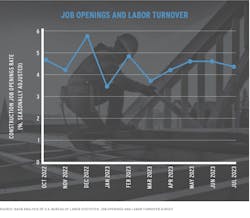WOTUS Rulings Cause Confusion for Home Builders
The saga of federal regulation of waters of the United States (WOTUS) has taken another disappointing turn for the building industry. After the U.S. Supreme Court’s ruling in the case of Sackett v. Environmental Protection Agency that clarified the federal government’s authority over only relatively permanent waterbodies, the U.S. Army Corps of Engineers and the EPA suspended the issuance of approved jurisdiction determinations (AJDs) nationwide until those agencies finalize an amended WOTUS rule.
The suspension of AJDs leaves land developers and builders unclear as to what features on their properties are subject to the Clean Water Act’s permitting requirements. Worse, the amended rule from the Biden administration fails to provide a definition of a “relatively permanent” waterbody, and it does not exclude from federal jurisdiction features that only contain water after a rainfall event (that is, “ephemeral features”).
The amended WOTUS rule suspending AJDs, which was prepared without any public input from stakeholders, misses an opportunity to provide regulatory certainty to the home building industry. Instead, it will lead to continued federal overreach, bureaucratic delays during the wetlands permitting process, and regulatory confusion for our industry.
RELATED
- The EPA Is Expanding Its List of Protected Waterways—Here’s Why Industry Associations Are Pushing Back
- Mud Puddles No Longer Deemed Protected Waters
- NAHB, Builders Score Big Win in SCOTUS Decision on WOTUS
Additional Sources of WOTUS Confusion
The new rule itself is not the only source of confusion. Before the Supreme Court released its Sackett decision, federal district courts in 27 states had already issued preliminary injunctions against the previous Biden WOTUS rule that went into effect in March 2023. Those injunctions also prevent the EPA and the Corps from implementing the more recently amended WOTUS rule in those states.
Therefore, the revised WOTUS definition only applies in 23 states, the District of Columbia, and the U.S. Territories. For the other 27 states, EPA and the Corps are relying on their prior interpretation of WOTUS, as well as the recent Sackett ruling.
Moving forward, the National Association of Home Builders’ (NAHB) priority is to get the EPA and the Corps to resume issuance of AJDs and Clean Water Act permits consistent with the Sackett ruling. NAHB also continues to meet with officials from the two agencies to ensure this latest WOTUS rule is being implemented consistently and efficiently nationwide. NAHB’s membership supports a federal wetlands program that maintains environmental protection of our nation’s waterways but also restores common sense and predictability to the federal wetlands permitting process.
Construction Open-Jobs Data
The construction labor market continued to cool in July, as the number of open construction jobs decreased to 363,000 or 4.4% from the previous month. This estimate comes seven months after a high of 488,000 in December 2022. The overall trend reflects a slowing of the housing market, with notable upticks in month-to-month volatility since late last year (see chart, below) and is now entering a stop-start cooling stage as the housing market adjusts to higher interest rates.
NAHB economists anticipate additional weakening of housing and labor during the second half of 2023. Still, the housing market remains underbuilt and requires additional labor and lots, as well as lumber and other building materials, in order to add inventory.
Despite some cooling in the housing market, attracting skilled labor will continue to be important for construction firms in the coming years. A slowing housing market will take some pressure off tight labor markets in the short term, but the long-term labor challenge will persist beyond the ongoing macro slowdown.



